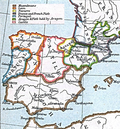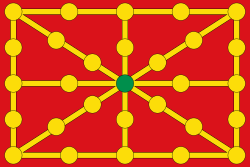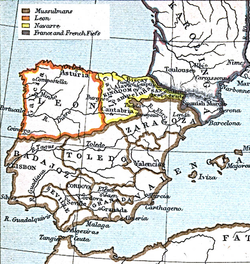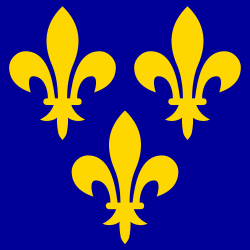Navarrské království
| Navarrské království Nafarroako Erresuma (baq) Reino de Navarra (es) Royaume de Navarre (fr) Reiaume de Navarra (oc) Regnum Navarrae (la)
| |||||||||||||||||||||
Geografie
| |||||||||||||||||||||
10 000 km² (rok 1300) | |||||||||||||||||||||
| Obyvatelstvo | |||||||||||||||||||||
100 000 (rok 1300) | |||||||||||||||||||||
| |||||||||||||||||||||
| |||||||||||||||||||||
| Státní útvar | |||||||||||||||||||||
feudální dědičná monarchie | |||||||||||||||||||||
Vznik | 824 – bitva v průsmysku Roncevaux, osamostatnění na Franské říši 905 – korunovace Sancha I. 1162 – Sancho VI. užívá titulu král navarrský | ||||||||||||||||||||
Zánik | |||||||||||||||||||||
| Státní útvary a území | |||||||||||||||||||||
| |||||||||||||||||||||
Navarrské království (baskicky Nafarroako Erresuma, španělsky Reino de Navarra, francouzsky Royaume de Navarre, latinsky Regnum Navarrae), původně Pamplonské království (baskicky Iruñeko Erresuma), bylo evropské království ležící na Pyrenejském poloostrově u Atlantského oceánu. Jeho hlavním městem byla Pamplona (baskicky Iruña či Iruñea). Za datum vzniku království se tradičně pokládá rok 824, kdy tamní baskický vůdce Íñigo Arista získal titul pamplonského krále a ukončil nadvládu Franské říše. Teprve v roce 1162 začal Sancho VI. jako první užívat titul krále navarrského (Rex Navarre).
Většina území zaniklého království je v součástí Španělska. Malá část severně od Pyrenejí je součástí Francie.[1]
Historie
Navarrské království v době svého největšího územního rozsahu, na konci vlády Sancha III. (1035), zahrnovalo dnešní španělské země Navarra, Baskicko, La Riola, Kantábrie a severní části Kastilie a Aragonu.[1] Postupně se od něj oddělily jako samostatné království Kastilie a Aragon.[1] S Aragonským královstvím byla Navarra v letech 1054–1134 spojena personální unií a později také s Francií v letech 1285–1328.[1] V průběhu 12. století byla západní část Navarry (dnešní Baskicko a La Riola) připojeny ke Kastilii.
V roce 1513 anektovala Kastilie část Navarrského království jižně od Pyrenejí (Horní Navarra).[1] Malá část království ležící severně od Pyrenejí (Dolní Navarra), zůstala nezávislá. Její král Jindřich III. Bourbonský se roku 1589 stal králem Francie a Navarra byla spojena personální unií s Francií.[1] Za vlády Jindřichova syna Ludvíka XIII. byla v roce 1620 personální unie obou zemí zrušena a Navarra byla začleněna do Francouzského království, čímž Navarrské království zaniklo. Toto území ovšem užívalo společně s provincií Béarn jistý stupeň autonomie až do roku 1792.[1] Poslední zbytky autonomie španělské části byly zrušeny v roce 1841.[1]
Geografie
- Navarra během největšího rozsahu, žlutě (1030)
- Navarrské království v roce 1210
- Navarrské království (tmavá červená) v roce 1400
Symbolika
- vlajka:
- standarta pamplonského krále (se znakem dle pečeti Sancha III.)
- raná korouhev krále Navarry na začátku 13. století se znakem od roku 1212
- pozdní standarta navarrských králů
- znak království:
- štít z pečeti Sancha VI. (1150–1194)
- znaky dynastií:
- dynastie Jimenézů
Odkazy
Poznámky
Reference
Související články
Externí odkazy
 Obrázky, zvuky či videa k tématu Navarrské království na Wikimedia Commons
Obrázky, zvuky či videa k tématu Navarrské království na Wikimedia Commons
Média použitá na této stránce
Autor: Sodacan, Licence: CC BY-SA 3.0
Královská standarda francouzského krále (používaný jako státní vlajka Francouzským královstvím v období absolutní monarchie). Používaná byla v letech 1638 až 1790.
Autor: previous version User:Ignaciogavira ; current version HansenBCN, designs from SanchoPanzaXXI, Licence: CC BY-SA 3.0
Flag of Spain (1785-1873 and 1875-1931)
Autor: Heralder, Licence: CC BY-SA 3.0
Coat of Arms of Henry IV of France as King of Navarre, 1572-1589.
Autor: Heralder, Licence: CC BY-SA 3.0
Coat of arms of Navarre, 1700-1910
Autor: Heralder, Licence: CC BY-SA 3.0
Royal Coat of Arms of Navarre, 1483-1512.
Autor: Heralder, Licence: CC BY-SA 3.0
Royal Banner of Navarre (Early Design)
Autor: Heralder, Licence: CC BY-SA 3.0
Royal Coat of Arms of Navarre, 1479-1483.
Autor: Tento vektorový obrázek byl vytvořen programem Inkscape od v ., Licence: CC BY-SA 3.0
Royal Banner of the Kingdom and Crown of Aragón
Autor: Heralder, Licence: CC BY-SA 3.0
Coat of arms of Navarre (c.1580-1700)
Autor: Heralder, Licence: CC BY-SA 3.0
Evolution Coat of Arms of Navarre-1
A flag used during the Umayyad dynasty (660–750)
Autor: Heralder, Licence: CC BY-SA 3.0
Royal Coat of Arms of Navarre, 1425-1479.
Autor:
Nations on the Iberian peninsula in the year 1400 C.E.
Autor: Heralder, Licence: CC BY-SA 3.0
Royal Coat of Arms and Heraldic Shield of Navarre, 1234/1259-1284.
Autor: Fuxius, Licence: CC BY-SA 4.0
Nafarroako Erresumaren kokapena 1190eko Europan.
Autor: Miguillen, Licence: CC BY-SA 4.0
Bandera de Navarra (versión antigua)
Autor: Dragovit, Licence: CC BY-SA 4.0
Banner of the Carolingian dynasty according to the Osprey Men at Arms, The Age of Charlemagne illustration of artist Angus McBride.
Black eagle, Basque nationalist flag, designed after the seal of Sancho III the Great.
Autor: Tom Lemmens, Licence: CC BY-SA 3.0
Coat of Arms of the Kingdom of Navarre (Commonly used before the 17th Century)
Autor: Heralder, Licence: CC BY-SA 3.0
Royal Coat of Arms and Heraldic Shield of Navarre, 1285-1328.
Map of Kigndom of Navarra, after 1250. From Historical Atlas by William Shepard (New York: Henry Holt and Company, 1911).
Autor: Heralder, Licence: CC BY-SA 3.0
Royal Coat of Arms of Navarre, 1328-1425.
Autor: Miguillen, Licence: CC BY 3.0
The Kingdom of Navarre from 1463–1530, with Upper Navarre in red and Lower Navarre in pink. Separate lands under the dominion of the House of Foix (green) and the House of Albret (purple) also included.


















































